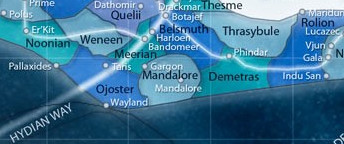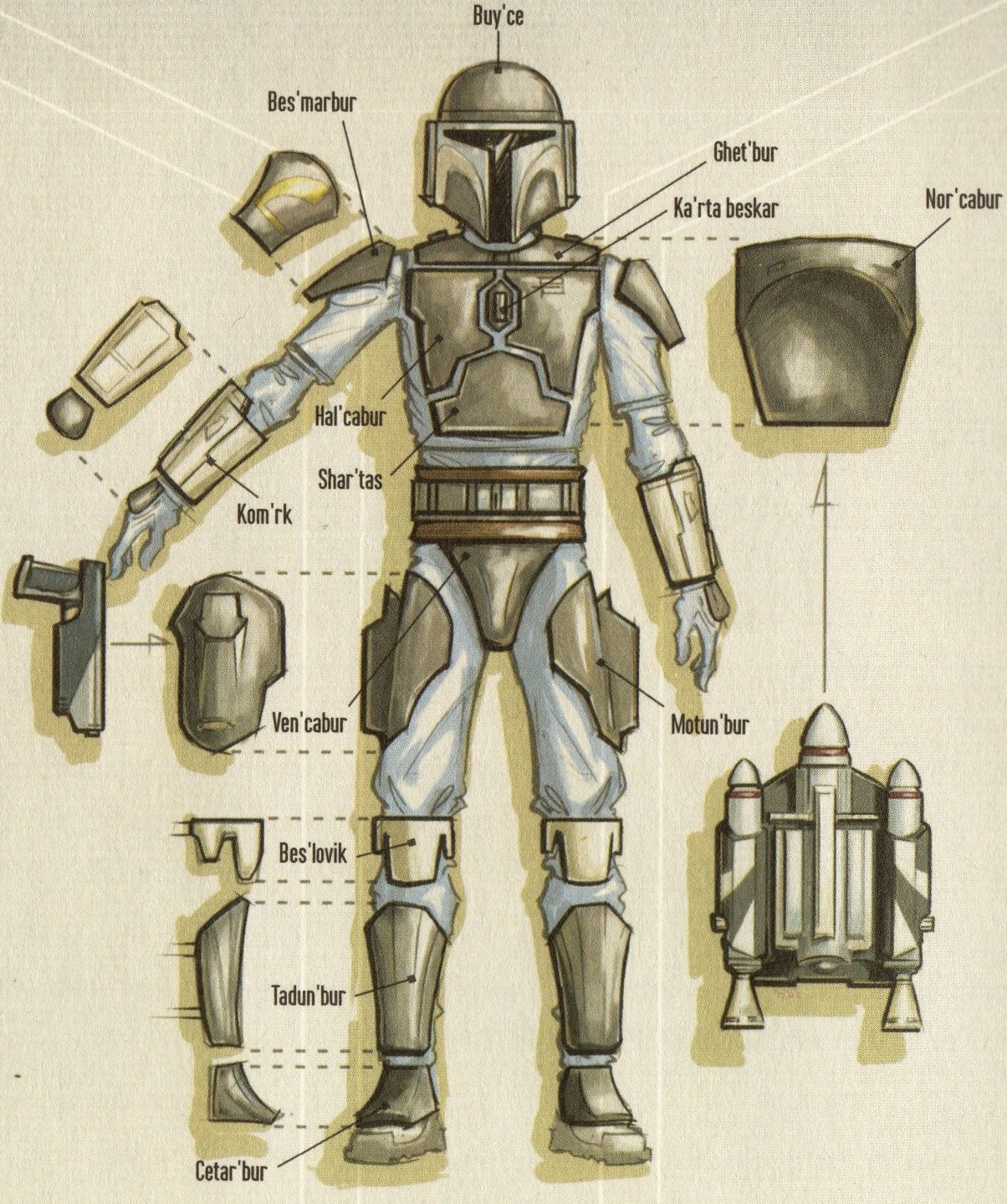Mandalore the Uniter was the title adopted by the mercenary Aga Awaud when he became the leader of the Mandalorian warrior culture during the final century of the New Sith Wars. In 1058 BBY, he returned to the planet Mandalore and discovered that the galaxy-wide Candorian plague epidemic had killed his family and most of Clan Awaud and that raiders and pirates endangered starship travel through Mandalorian Space.
Seven years later, Awaud became the leader, or Mandalore, of his people and began the Return movement that aimed to recall Mandalorians to defend their original homeworld and its surrounding space. Mandalore the Uniter also initiated reforms in Mandalorian military structure and the manufacture of the culture's traditional armor. Under his rule and that of his successor Mandalores, Mandalorian Space became a powerful and influential regional entity offering protection to neighboring sectors, and his legacy in the Mandalorian history and culture eventually endured for more than one thousand years.
The Mandalorian who would eventually be known as Mandalore the Uniter was originally a mercenary named Aga Awaud who lived during the final century of the New Sith Wars of 2000 BBY to 1000 BBY. A member of Clan Awaud, he had a family on Mandalore, the Outer Rim Territories planet that was the original home of the Mandalorian warrior culture. By 1060 BBY, Mandalore had fallen victim to the galaxy-wide Candorian plague outbreak, with Awaud's family and most of his clan being among the casualties. In addition, fear of raiders and pirates from the lawless sectors surrounding Mandalorian Space forced Mandalorian starships to group together into caravans for travel through that region. When Awaud returned to Mandalore in 1058 BBY, he was appalled by the fate of his kin and the state of Mandalorian-controlled space.

Mandalore the Uniter led a resurgence of Mandalorian Space (Mandalore sector borders in 0 ABY depicted).
In 1051 BBY, in an unexpected turn of Mandalorian history, the mercenary became Mandalore, leader of the Mandalorian people, and initiated the Return, a movement that encouraged Mandalorians, including the most capable members of the culture, from throughout the galaxy to return to Mandalorian Space and defend it. Mandalore the Uniter formed a new shock trooper order that would rely on speed and surprise during attacks and be more mobile than the Mandalorian Neo-Crusaders of the 3976 BBY–3960 BBY Mandalorian Wars. To achieve that, the Mandalore restarted mass production of the traditional Mandalorian armor and split it into separate, lighter components in order not to overburden the fuel supplies of the warriors' jetpacks. The general composition of Mandalore the Uniter's armor would eventually become the basis for that worn as late as during the Second Imperial Civil War that began in 137 ABY.

Mandalorian armor introduced by Mandalore the Uniter served as the basis for that used throughout the subsequent millennium (Death Watch armor depicted).
Under the leadership of Mandalore the Uniter as well as the strong Mandalores who succeeded him, Mandalorian Space thrived and became a regional industrial power, with the Mandalorians offering protection services to many neighboring star systems and sectors. Over the subsequent centuries, the culture grew in power and influence to the point where the Galactic Republic came to view it as a threat, which ultimately led to disastrous consequences for the Mandalorians and deep factional divides in their society.
A millennium after the reign of Mandalore the Uniter, his role in the resurgence of the Mandalorian people and the evolution of their armor was noted in Ba'jurne Kyr'tsad Mando'ad, a manifesto of the Death Watch Mandalorian splinter group. The document was supposedly written by the movement's leader, Tor Vizsla—although the Death Watch's opponent Jango Fett doubted its authenticity—and was eventually included in the book The Bounty Hunter Code by Jango's son, the bounty hunter Boba Fett. Vilnau Teupt similarly mentioned Mandalore the Uniter—whose clan had survived for at least one thousand years by the time of the Galactic Civil War—and his role in Mandalorian history in the keynote address "Industry, Honor, Savagery: Shaping the Mandalorian Soul" at Brentaal Academy's 412th Proceedings of Galactic Anthropology and History in 24 ABY.
Mandalore the Uniter wore a set of Mandalorian armor. It included a helmet; torso, shoulder, and forearm plates; and a belt with several pouches. The paint pattern of the armor plates consisted of irregular light lines against the backdrop of the darker armor itself. The back section of the Mandalore's armor included several vertical spikes.

Mandalore the Uniter was introduced in The Essential Guide to Warfare.
Mandalore the Uniter was introduced in the 2012 reference book The Essential Guide to Warfare by Jason Fry and Paul R. Urquhart. In the book, the character is described in a section also mentioning Mandalore the Ultimate, who transformed the Mandalorian society into one including members of many different species while also ultimately becoming generally known as the last Mandalore who was a Taung—a member of the original Mandalorian species. Fry later noted that Mandalore the Uniter had been created as another transitional Mandalorian leader whose memory would have been celebrated by later Mandalorians of various political affiliations.
When Fry was asked on the Jedi Council Forums of TheForce.net whether the use of the title of "Mandalore the Uniter" in The Essential Guide to Warfare had been a reference to the cosplay character of the same name—used since 2008—portrayed by Tom Hutchens, the founder of the Mandalorian Mercs Costume Club, the author admitted that the similarity was a "lucky accident" while also praising that organization and expressing satisfaction at the unintentional connection. Hutchens was involved in the creation of Daniel Wallace's 2013 reference book The Bounty Hunter Code: From the Files of Boba Fett, in which the official Mandalore the Uniter was illustrated by Mark McHaley.
- The Essential Guide to Warfare
- The Bounty Hunter Code: From the Files of Boba Fett